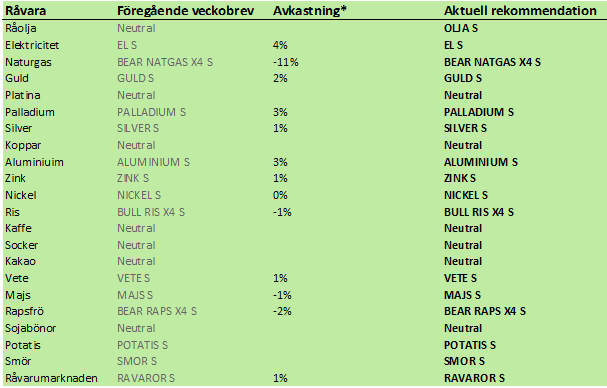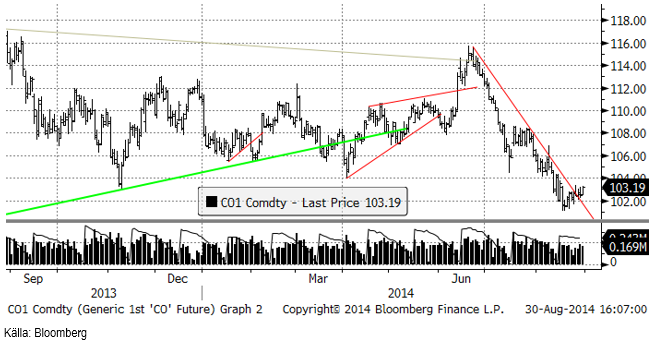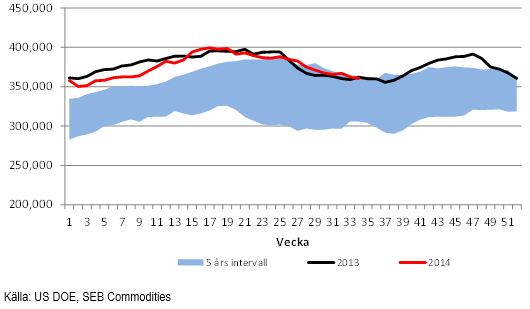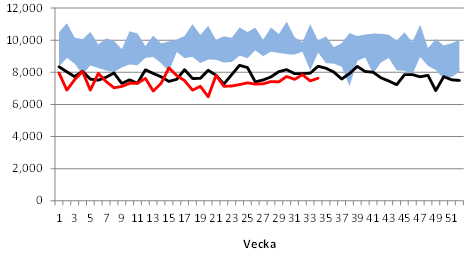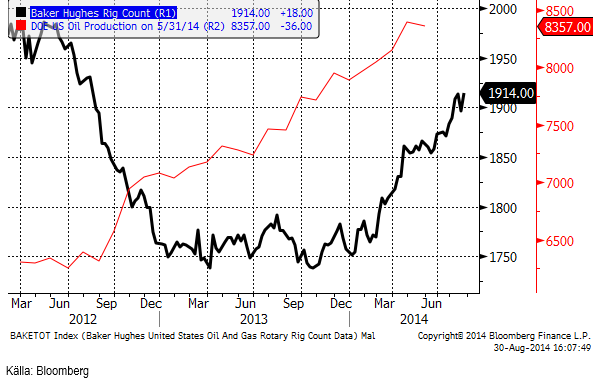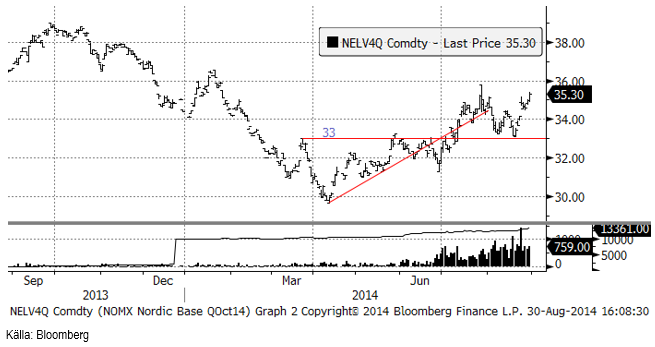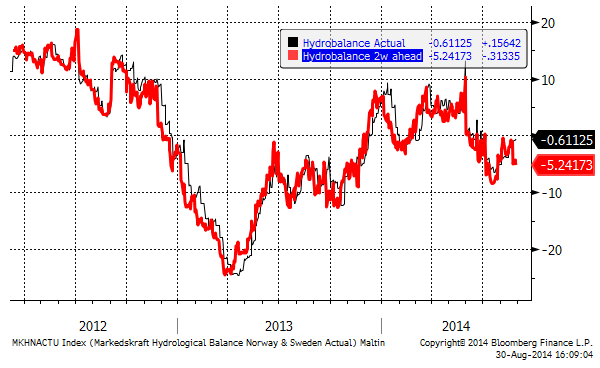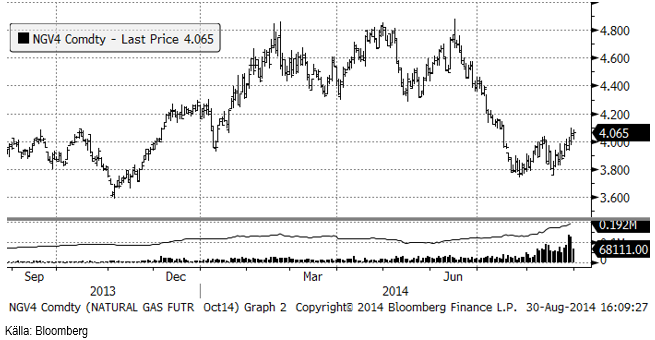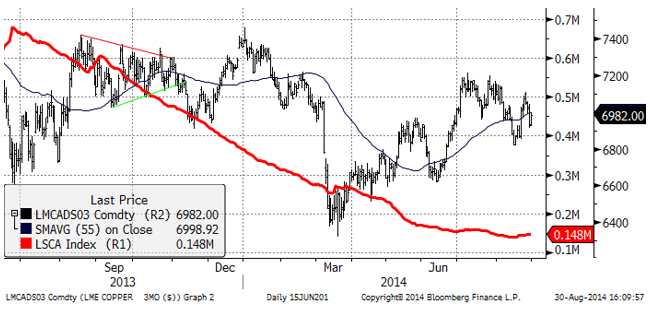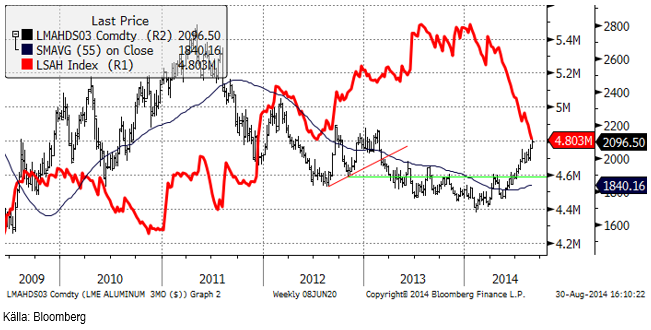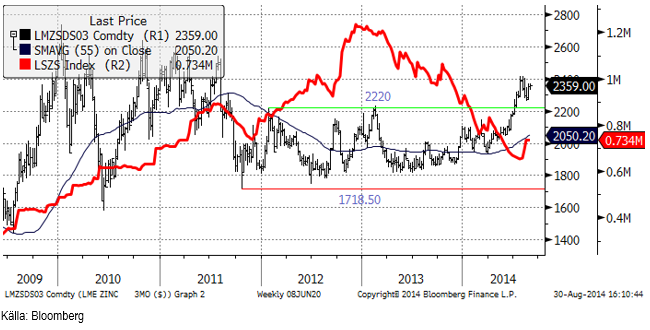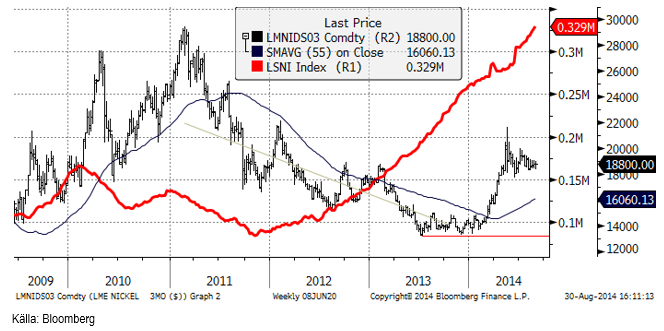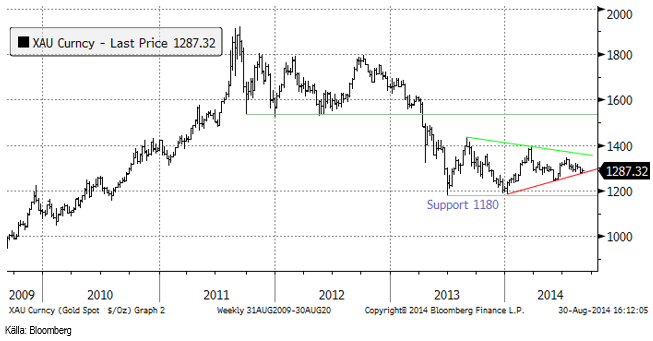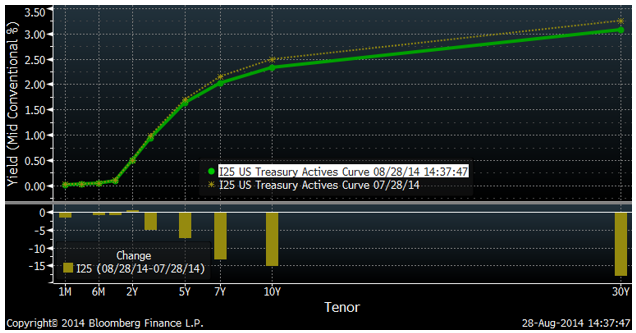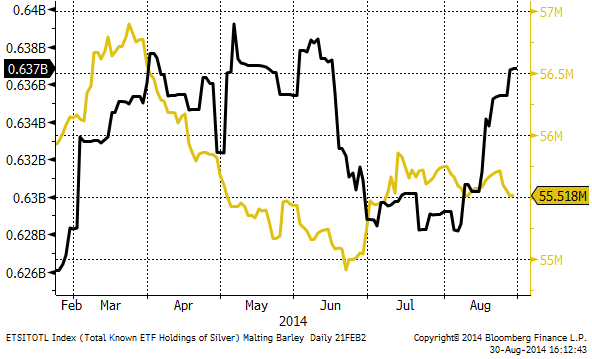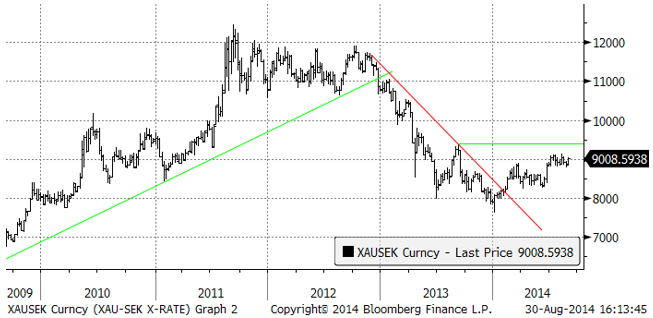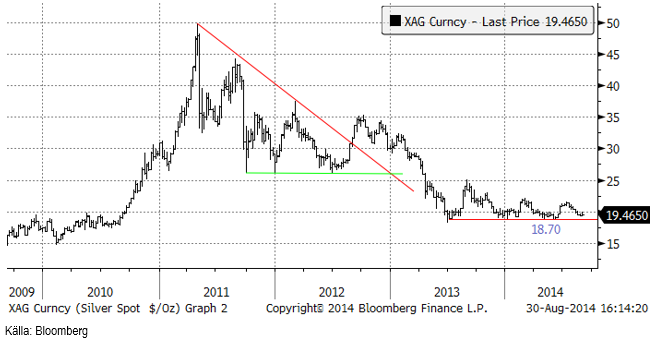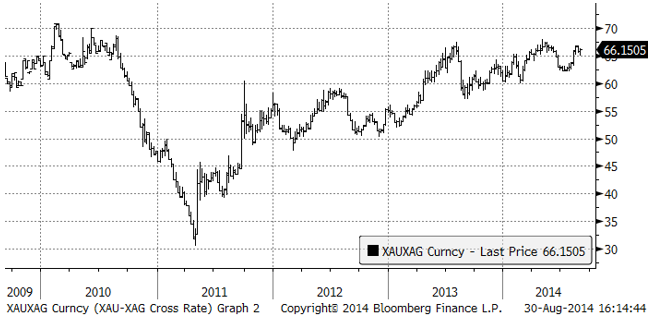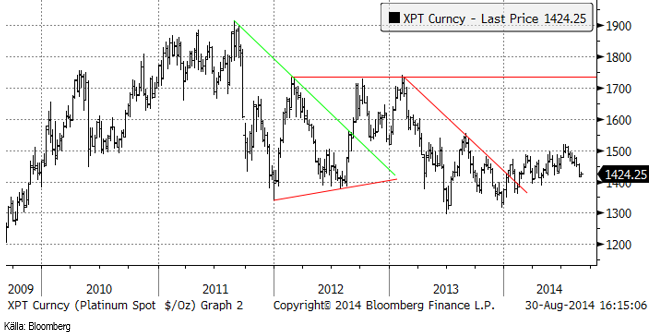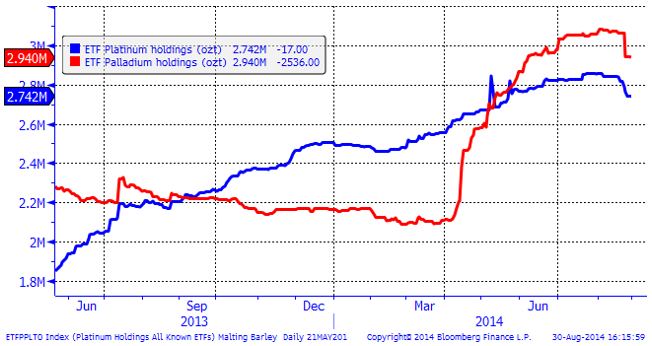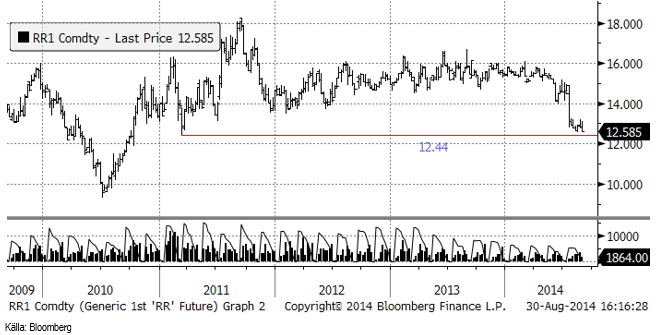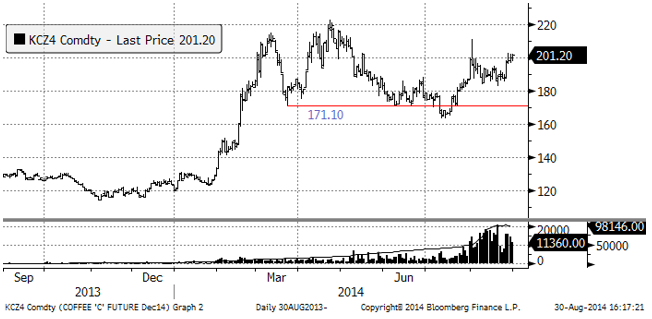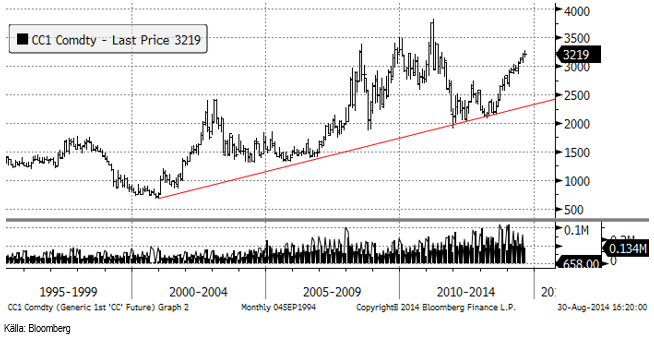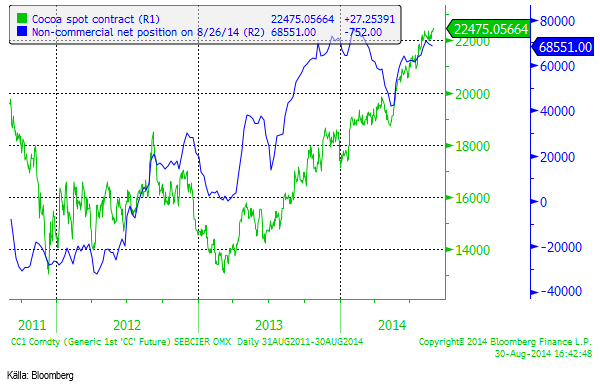Analys
SEB – Råvarukommentarer, 1 september 2014

Rekommendationer
Kort sammanfattning
Pga tilltagande geopolitisk oro tror vi att ädelmetaller och olja är bra att vara köpt på råvarumarknaden. Det finns ingen uppenbar råvara att vara kort den här veckan. SILVER S och OLJA S är alltså de rekommendationer vi vill lyfta fram.
Råolja – Brent
Oljepriset har brutit motståndet för den nedgång som varit sedan juni. Vi tror att det finns potential för uppsida och det motiveras bland annat av att OPEC har producerat maximalt och det finns en viss sårbarhet med ISIS som motor i MENA. Libyen känns också skakigt då t ex den amerikanska ambassaden i Tripoli intogs i helgen. Slutligen har vi Ryssland/Ukraina-krisen och vinter på norra halvklotet på väg.
Råoljelagren i USA sjönk 2 mbbl till 360.5 mbbl. Nu är lagernivån faktiskt 1.5 mbbl lägre än samma vecka förra året.
Importen av olja ökade 0.2 mbbl i veckans rapport från DOE, men ligger 0.7 mbbl under förra årets nivå samma vecka. Man brukar se en ökning av importen under juni, juli och augusti och en topp i alldeles i slutet av augusti. Under september, oktober, november och december, faktiskt ända fram till mitten av mars, minskar importen successivt. Det är möjligt att USA:s veckovisa import når ner till 6 mbbl någon gång under den här perioden. Det var väldigt nära den nivån i mitten av maj i år.
Nedan ser vi ett diagram på antalet oljeriggar i USA, enligt Baker Hughes statistik (svart) och USA:s oljeproduktion enligt US DOE på 8.357 mbpd. Antalet borr-riggar steg återigen över 1900.
Vi rekommenderar alltså på kort sikt köp i olja, t ex via OLJA S.
Elektricitet
China minskar ytterligare på koleldad elkraft. Samtidigt kämpar 50% av kolgruvorna i världen med lönsamhetsproblem. Terminerna för kol i Europa har fallit till 80 dollar per ton för kalenderår 2015. I Euro-termer har kolpriset varit stabilt, men euron har varit svag då den svaga tillväxten i EU tynger. Ukrainakrisen tynger lite extra, men vintern är i antågande och Ukrainakrisen skapar också oro för energitillförseln.
På kort sikt tror vi att elpriset faktiskt testar och troligtvis bryter motståndsnivåerna.
Hydrologisk balans har enligt 2-veckors prognosen försvagats.
Vi rekommenderar köp av EL S om priset kommer ner lite.
Naturgas
Naturgaspriset har inte alls gått åt vårt håll den senaste veckan, men rekylen uppåt borde stöta på patrull vid 4.20, som är ett tekniskt motstånd. Med viss tvekan håller vi fast vid vår investering i t ex BEAR NATGAS X4 S.
Koppar
Kopparmarknaden ägnade förra veckan åt konsolidering efter den senaste tidens prisuppgång. Kanske funderar marknadens aktörer på vad orsaken var till den plötsliga prisuppgången, om det var något annat än att några hamnade snett i en annars ganska ”tight” marknad. Marknaden har varit i backwardation hela året och det gör det dyrt att ha en kort position. Utbudet kommer dock att öka, bland annat på grund av återupptagningen av export från Grasberg-gruvan. Vi kan dock inte riktigt se att detta kommer att leda till prisfall i kopparmarknaden. Konsumtionen väntas också växa i en hygglig takt och som vi har påpekat förut – risken finns att Kina börjar köpa metall till sina strategiska lager. Det räcker med möjligheten för detta, för att stabilisera marknaden på nedsidan.
Vi rekommenderar neutral position i koppar.
Aluminium
Konsumenterna av aluminium väntar på att priset ska falla tillbaka så att de kan prissäkra sig. Priset har dock gått upp varje dag de senaste två veckorna, bortsett från en dag. Sammantaget är prisuppgången 6% på två veckor, vilket är mycket för aluminium som vanligtvis är den minst volatila av basmetallerna. Premien för fysisk metall (US Midwest) ligger på 450 dollar per ton, vilket är 150 dollar mer än före sommaren, vilket tyder på att det finns ett oväntat sug efter metall. Många konsumenter lever antagligen ”ur hand i mun” och försöker köpa så lite som möjligt. Det betyder att nedgångar kan bli grunda, då dessa passar på att köpa.
Tekniskt ger trendkanalen motstånd vid 2175 dollar just nu, vilket är ytterligare 3% över dagens nivå. .
Vi fortsätter alltså med köprekommendation på ALUMINIUM S.
Zink
Zinkpriset närmar sig brytpunkt. Handeln var fast hela förra veckan. Vid sidan av aluminium är zink den mest populära metallen bland investerare för närvarande. Liksom i aluminium börjar en bättre fundamental balans att märkas. Ökad smältverksproduktion i Kina motverkar dock i någon mån den här processen. Trots detta är trenden klar, och det borde finnas utsikter för högre pris på zink. Tekniskt ser diagrammet ut att vilja bryta motstånden och gå högre. Ett brott av 2170 dollar / ton skulle signalera ytterligare ett kliv uppåt i prisnivå.
Vi rekommenderar köp av ZINK S.
Nickel
Den indonesiska handelskammaren har föreslagit att den nya regeringen ska tillåta export av nickelmalm. Villkoret för att få exportera malm ska enligt förslaget vara att exportören förbinder sig att bygga smältverk i Indonesien och att man betalar in 10% av investeringskostnaden till en investeringsfond. Företag måste också betala en exportskatt på 50-60%.
Den här nyheten är naturligtvis negativ för nickelpriset. Däremot blir det knappast billigt att exportera, men att möjligheten finns gör att sannolikheten för stora prisuppgångar i nickel minskar. Om priset går upp kraftigt pga materialbrist, kommer det att gå att få material från Indonesien. Marknaden tyckte uppenbarligen inte att nyheten skulle förändra utbuds- och efterfrågebalansen i nuvarande läge och priset förändrade sig inte mycket av den här anledningen på fredagen.
Guld
Priset på guld ligger fortfarande och testar den nedre gränsen i den triangelformation som bildats sedan mitten av förra året. Det är ännu oklart om det kommer att bli ett utbrott på nedsidan eller på uppsidan. Just nu är det som sagt väldigt nära till ett brott nedåt. Det innebär att taktiken är att köpa, men vara beredd att snabbt ta förlusten om det blir ett brott på nedsidan.
Tilltagande geopolitisk oro borde gynna guld som investering. Å andra sidan är det märkligt att guldpriset inte redan har stigit mer än det har. Om man bara tittade på prisutvecklingen på guld, skulle man tro att världen var ovanligt fridfull. Om man bor i Indien kan det kanske te sig så. Efterfrågan på guld i Indien hänger samman med monsunens utveckling. Den har varit svag hittills i år, som vi kunnat läsa tidigare. Nu kommer det dock att regna betydligt mycket mer än normalt de kommande två veckorna. Kanske kan detta ha en positiv påverkan på guldpriset.
Det talas om att räntorna är på väg uppåt i USA, men detta är inte något man ser i marknaden. Nedan ser vi räntekurvorna för amerikanska statspapper, där det tydligt framgår att räntorna generellt sett är lägre än för en månad sedan med ungefär 15 räntepunkter för 10 och 30 års obligationer.
Nedan ser vi att det varit inflöde i guldfonder (gul kurva, antal uns i ETF:er) under den senare delen av augusti. Vi har även märkt av att svenska placerare köpt guld, inte bara GULD S utan även fysiskt guld, vilket vi kan hjälpa till med för våra private bankingkunder.
Nedan ser vi guldpriset i svenska kronor per uns. Guld ser mer ”bullish” ut ur ett svenskt perspektiv, än ur ett dollarperspektiv.
Vi rekommenderar köp av GULD S.
Silver
Silver är vår favorit bland alla råvaror. Dels är har priset varit i konsolidering under mer än ett års tid efter prisfallet från toppnoteringen för tre år sedan, dels gynnas ädelmetaller av den förnyade och tilltagande geopolitiska oron och slutligen är silver billigt i förhållande till guld. Motståndet för nedgången från toppen 2011 är ännu inte bruten, men om eller när det sker, kan prisuppgången bli snabb och stor.
Det som särskilt lockar investerare till silver framför guld just nu är att silver är historiskt billigt jämfört med guld. Nedan ser vi ett diagram över priset på guld uttryckt i silver.
Vi anser att silver är mer köpvärt än guld och skulle vilja köpa på de här nivåerna. Vi rekommenderar köp av SILVER S.
Platina & Palladium
Platinapriset fann stöd och lyckades faktiskt stiga lite förra veckan, men trenden är trots detta nedåtriktad.
Prisdiagrammet på palladium ser vi nedan. Som vi ser gick priset över 900 dollar per uns och det talar för att prisuppgången kan fortsätta. 900 dollar var ett starkt motstånd.
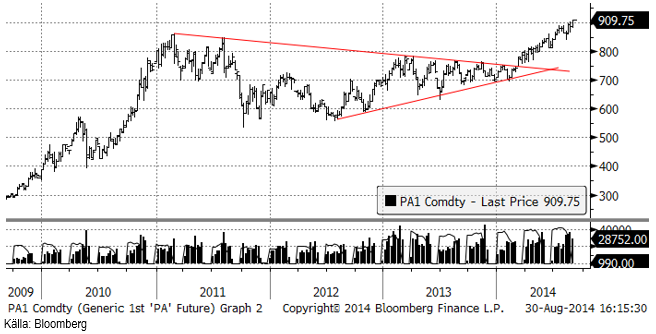
Nedanför ser vi hur mycket metall som finns i börshandlade fonder för platina respektive palladium. So vi ser har folk tagit hem sina vinster i båda den senaste veckan.
Vi är neutrala på platina men rekommenderar en köpt position i palladium.
Ris
Priset på ris (novemberkontraktet på CME) steg initialt men föll sedan tillbaka. Den statistik som kommit de senaste veckorna pekar på lägre skördar av ris i år. I veckan fick vi en sådan från Kina. Kinas tidiga risskörd minskade med 0.4% jämfört med förra året till 34 mt enligt National Bureau of Statistics i fredags.
Vi tycker inte att detta talar för ett fortsatt prisfall på ris, utan rekommenderar att man snarare investerar i RIS S.
Kaffe
Det är inga större nyheter på kaffefronten. Tekniskt ser vi att priset på decemberkontraktet tagit sig upp till 200 cent. Möjligen kommer priset att gå upp till 220 cent, där ett starkt motstånd finns. Fundamentalt ser vi dock inte något som talar för högre pris på kaffe.
Vi rekommenderar neutral position i kaffe.
Kakao
The International Cocoa Organization (”ICCO”) meddelade i fredags att 2013/14 kommer att ha ett produktionsöverskott på 40,000 ton och inte ett produktionsunderskott. Det beror på högre produktion än väntat i Elfenbenskusten. ICCO:s tidigare estimat var ett underskott på 75,000 ton. Marknadsföringsåret för kakao löper från den 1 oktober till 30 september.
Elfenbenskusten väntas enligt ICCO få en skörd på 1.73 mt (0.12 mt högre än tidigare väntat). Det innebär ett nytt rekord, i alla fall på papperet. Skörden 2010/11 kan ha varit högre, men det smugglades till grannländerna och skörden nu kan vara mindre, pga smuggling till Elfenbenskusten, enligt ICCO.
Även Ghana och Nigeria väntas få högre skördar, medan Kamerun och Ecuador får något lägre. Sammantaget gör ICCO en uppjustering av global produktion med 0.18 mt till 4.345 mt, vilket är ett nytt rekord. ICCO ser också att de afrikanska producenterna ökar sin produktionskapacitet och väntas fortsätta öka den 2014/15.
Globala lager ökar med 1.6 procentenheter till 38.9% av årlig konsumtion.
Spekulativ position ligger väldigt högt, historiskt sett.
Vi fortsätter med neutral position, men det börjar bli intressant att försöka sälja kakao om priset blir attraktivt. ”SHORT KAKAO A S” har en hävstång på -0.93 och kan vara ett lämpligt instrument att gå kort med.
För fler analyser på jordbruksråvaror se SEBs andra analysbrev.
[box]SEB Veckobrev Veckans råvarukommentar är producerat av SEB Merchant Banking och publiceras i samarbete och med tillstånd på Råvarumarknaden.se[/box]
Disclaimer
The information in this document has been compiled by SEB Merchant Banking, a division within Skandinaviska Enskilda Banken AB (publ) (“SEB”).
Opinions contained in this report represent the bank’s present opinion only and are subject to change without notice. All information contained in this report has been compiled in good faith from sources believed to be reliable. However, no representation or warranty, expressed or implied, is made with respect to the completeness or accuracy of its contents and the information is not to be relied upon as authoritative. Anyone considering taking actions based upon the content of this document is urged to base his or her investment decisions upon such investigations as he or she deems necessary. This document is being provided as information only, and no specific actions are being solicited as a result of it; to the extent permitted by law, no liability whatsoever is accepted for any direct or consequential loss arising from use of this document or its contents.
About SEB
SEB is a public company incorporated in Stockholm, Sweden, with limited liability. It is a participant at major Nordic and other European Regulated Markets and Multilateral Trading Facilities (as well as some non-European equivalent markets) for trading in financial instruments, such as markets operated by NASDAQ OMX, NYSE Euronext, London Stock Exchange, Deutsche Börse, Swiss Exchanges, Turquoise and Chi-X. SEB is authorized and regulated by Finansinspektionen in Sweden; it is authorized and subject to limited regulation by the Financial Services Authority for the conduct of designated investment business in the UK, and is subject to the provisions of relevant regulators in all other jurisdictions where SEB conducts operations. SEB Merchant Banking. All rights reserved.
Analys
Tightening fundamentals – bullish inventories from DOE

The latest weekly report from the US DOE showed a substantial drawdown across key petroleum categories, adding more upside potential to the fundamental picture.

Commercial crude inventories (excl. SPR) fell by 5.8 million barrels, bringing total inventories down to 415.1 million barrels. Now sitting 11% below the five-year seasonal norm and placed in the lowest 2015-2022 range (see picture below).
Product inventories also tightened further last week. Gasoline inventories declined by 2.1 million barrels, with reductions seen in both finished gasoline and blending components. Current gasoline levels are about 3% below the five-year average for this time of year.
Among products, the most notable move came in diesel, where inventories dropped by almost 4.1 million barrels, deepening the deficit to around 20% below seasonal norms – continuing to underscore the persistent supply tightness in diesel markets.
The only area of inventory growth was in propane/propylene, which posted a significant 5.1-million-barrel build and now stands 9% above the five-year average.
Total commercial petroleum inventories (crude plus refined products) declined by 4.2 million barrels on the week, reinforcing the overall tightening of US crude and products.


Analys
Bombs to ”ceasefire” in hours – Brent below $70

A classic case of “buy the rumor, sell the news” played out in oil markets, as Brent crude has dropped sharply – down nearly USD 10 per barrel since yesterday evening – following Iran’s retaliatory strike on a U.S. air base in Qatar. The immediate reaction was: “That was it?” The strike followed a carefully calibrated, non-escalatory playbook, avoiding direct threats to energy infrastructure or disruption of shipping through the Strait of Hormuz – thus calming worst-case fears.

After Monday morning’s sharp spike to USD 81.4 per barrel, triggered by the U.S. bombing of Iranian nuclear facilities, oil prices drifted sideways in anticipation of a potential Iranian response. That response came with advance warning and caused limited physical damage. Early this morning, both the U.S. President and Iranian state media announced a ceasefire, effectively placing a lid on the immediate conflict risk – at least for now.
As a result, Brent crude has now fallen by a total of USD 12 from Monday’s peak, currently trading around USD 69 per barrel.
Looking beyond geopolitics, the market will now shift its focus to the upcoming OPEC+ meeting in early July. Saudi Arabia’s decision to increase output earlier this year – despite falling prices – has drawn renewed attention considering recent developments. Some suggest this was a response to U.S. pressure to offset potential Iranian supply losses.
However, consensus is that the move was driven more by internal OPEC+ dynamics. After years of curbing production to support prices, Riyadh had grown frustrated with quota-busting by several members (notably Kazakhstan). With Saudi Arabia cutting up to 2 million barrels per day – roughly 2% of global supply – returns were diminishing, and the risk of losing market share was rising. The production increase is widely seen as an effort to reassert leadership and restore discipline within the group.
That said, the FT recently stated that, the Saudis remain wary of past missteps. In 2018, Riyadh ramped up output at Trump’s request ahead of Iran sanctions, only to see prices collapse when the U.S. granted broad waivers – triggering oversupply. Officials have reportedly made it clear they don’t intend to repeat that mistake.
The recent visit by President Trump to Saudi Arabia, which included agreements on AI, defense, and nuclear cooperation, suggests a broader strategic alignment. This has fueled speculation about a quiet “pump-for-politics” deal behind recent production moves.
Looking ahead, oil prices have now retraced the entire rally sparked by the June 13 Israel–Iran escalation. This retreat provides more political and policy space for both the U.S. and Saudi Arabia. Specifically, it makes it easier for Riyadh to scale back its three recent production hikes of 411,000 barrels each, potentially returning to more moderate increases of 137,000 barrels for August and September.
In short: with no major loss of Iranian supply to the market, OPEC+ – led by Saudi Arabia – no longer needs to compensate for a disruption that hasn’t materialized, especially not to please the U.S. at the cost of its own market strategy. As the Saudis themselves have signaled, they are unlikely to repeat previous mistakes.
Conclusion: With Brent now in the high USD 60s, buying oil looks fundamentally justified. The geopolitical premium has deflated, but tensions between Israel and Iran remain unresolved – and the risk of missteps and renewed escalation still lingers. In fact, even this morning, reports have emerged of renewed missile fire despite the declared “truce.” The path forward may be calmer – but it is far from stable.
Analys
A muted price reaction. Market looks relaxed, but it is still on edge waiting for what Iran will do

Brent crossed the 80-line this morning but quickly fell back assigning limited probability for Iran choosing to close the Strait of Hormuz. Brent traded in a range of USD 70.56 – 79.04/b last week as the market fluctuated between ”Iran wants a deal” and ”US is about to attack Iran”. At the end of the week though, Donald Trump managed to convince markets (and probably also Iran) that he would make a decision within two weeks. I.e. no imminent attack. Previously when when he has talked about ”making a decision within two weeks” he has often ended up doing nothing in the end. The oil market relaxed as a result and the week ended at USD 77.01/b which is just USD 6/b above the year to date average of USD 71/b.

Brent jumped to USD 81.4/b this morning, the highest since mid-January, but then quickly fell back to a current price of USD 78.2/b which is only up 1.5% versus the close on Friday. As such the market is pricing a fairly low probability that Iran will actually close the Strait of Hormuz. Probably because it will hurt Iranian oil exports as well as the global oil market.
It was however all smoke and mirrors. Deception. The US attacked Iran on Saturday. The attack involved 125 warplanes, submarines and surface warships and 14 bunker buster bombs were dropped on Iranian nuclear sites including Fordow, Natanz and Isfahan. In response the Iranian Parliament voted in support of closing the Strait of Hormuz where some 17 mb of crude and products is transported to the global market every day plus significant volumes of LNG. This is however merely an advise to the Supreme leader Ayatollah Ali Khamenei and the Supreme National Security Council which sits with the final and actual decision.
No supply of oil is lost yet. It is about the risk of Iran closing the Strait of Hormuz or not. So far not a single drop of oil supply has been lost to the global market. The price at the moment is all about the assessed risk of loss of supply. Will Iran choose to choke of the Strait of Hormuz or not? That is the big question. It would be painful for US consumers, for Donald Trump’s voter base, for the global economy but also for Iran and its population which relies on oil exports and income from selling oil out of that Strait as well. As such it is not a no-brainer choice for Iran to close the Strait for oil exports. And looking at the il price this morning it is clear that the oil market doesn’t assign a very high probability of it happening. It is however probably well within the capability of Iran to close the Strait off with rockets, mines, air-drones and possibly sea-drones. Just look at how Ukraine has been able to control and damage the Russian Black Sea fleet.
What to do about the highly enriched uranium which has gone missing? While the US and Israel can celebrate their destruction of Iranian nuclear facilities they are also scratching their heads over what to do with the lost Iranian nuclear material. Iran had 408 kg of highly enriched uranium (IAEA). Almost weapons grade. Enough for some 10 nuclear warheads. It seems to have been transported out of Fordow before the attack this weekend.
The market is still on edge. USD 80-something/b seems sensible while we wait. The oil market reaction to this weekend’s events is very muted so far. The market is still on edge awaiting what Iran will do. Because Iran will do something. But what and when? An oil price of 80-something seems like a sensible level until something do happen.
-

 Nyheter3 veckor sedan
Nyheter3 veckor sedanMahvie Minerals växlar spår – satsar fullt ut på guld
-

 Nyheter4 veckor sedan
Nyheter4 veckor sedanUppgången i oljepriset planade ut under helgen
-

 Nyheter4 veckor sedan
Nyheter4 veckor sedanLåga elpriser i sommar – men mellersta Sverige får en ökning
-

 Nyheter3 veckor sedan
Nyheter3 veckor sedanJonas Lindvall är tillbaka med ett nytt oljebolag, Perthro, som ska börsnoteras
-

 Analys3 veckor sedan
Analys3 veckor sedanA muted price reaction. Market looks relaxed, but it is still on edge waiting for what Iran will do
-

 Nyheter3 veckor sedan
Nyheter3 veckor sedanOljan, guldet och marknadens oroande tystnad
-

 Analys4 veckor sedan
Analys4 veckor sedanVery relaxed at USD 75/b. Risk barometer will likely fluctuate to higher levels with Brent into the 80ies or higher coming 2-3 weeks
-

 Nyheter3 veckor sedan
Nyheter3 veckor sedanDomstolen ger klartecken till Lappland Guldprospektering


